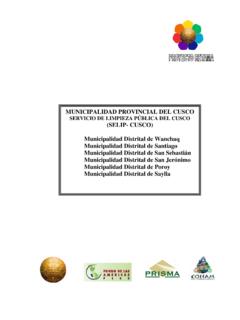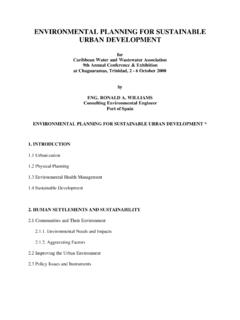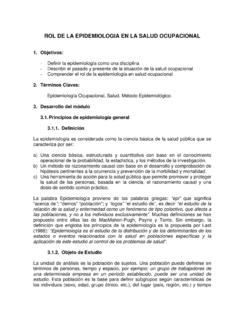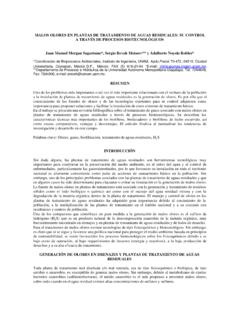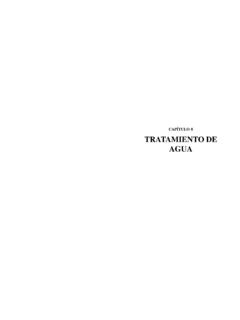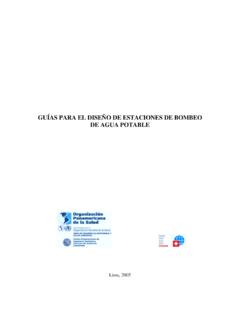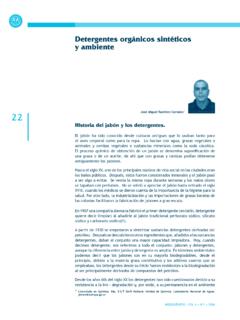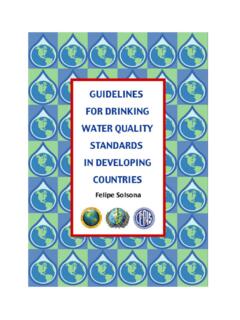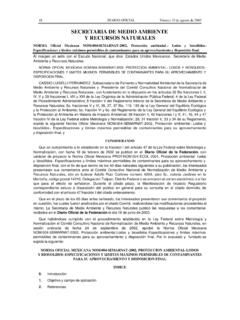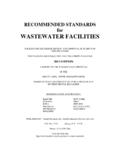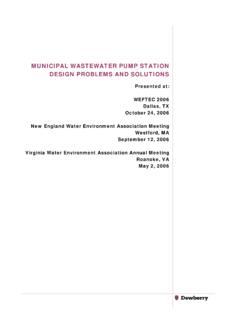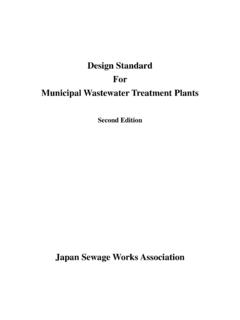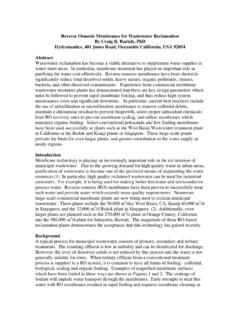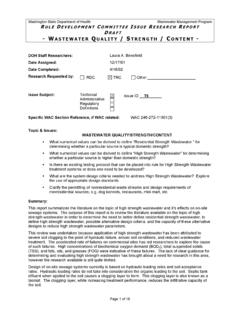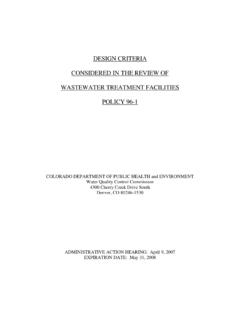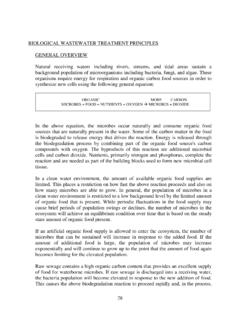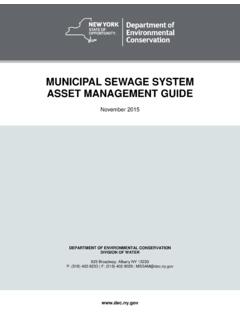Transcription of SECTION 5 DESIGN OF COMMON EFFLUENT TREATMENT …
1 5-1 SECTION 5 DESIGN OF COMMON EFFLUENT TREATMENT PLANTSFOR NONHAZARDOUS INDUSTRIAL WASTEWATERThis SECTION addresses major considerations for DESIGN and selection of treatmentprocesses for COMMON EFFLUENT TREATMENT plants (CETPs) using conventional wastewatertreatment technologies. CETPs are designed only to treat nonhazardous industrial wastewaterand should focus on simple technology that is cost-effective, requires low maintenance, andhas minimal operator requirements. These plants should include processes such as pHadjustment, aerated lagoons, sedimentation/facultative basins, and polishing/infiltration of these TREATMENT processes are discussed SECTION assumes that a piping network or some other collection system ( , tanktrucks) is in place that carries wastewater from individual sources to the CETP.
2 This sectionalso assumes that industrial wastewaters have been pretreated to remove corrosive and toxicsubstances that would adversely affect the operation of conventional wastewater TREATMENT andcollection processes or that toxic discharges have been directed to TREATMENT facilities designedspecifically for hazardous wastes. SECTION 6 covers the DESIGN of centralized TREATMENT facilitiesfor hazardous BASISD esign of an industrial CETP is highly site specific. Major general considerations aresite characteristics (see SECTION ) and wastewater characteristics (see SECTION ).Pretreatment standards for waters entering the collection system serving the CETP, andtreatment standards for EFFLUENT discharged from the CETP also are significant designconsiderations (see SECTION ).
3 Within the framework of site and wastewater characteristicsand TREATMENT standards (see SECTION ), TREATMENT process selection involves considerationof numerous factors, such as TREATMENT efficiency, reliability, and cost (see SECTION ).Major references that address preliminary and detailed engineering wastewater treatmentdesign in more detail include Metcalf and Eddy (1979), Fresenius et al. (1989), Patterson(1978), Qasim (1985), Sundstrom and Klei (1979), WEF/ASCE (1992), and Martin andMartin (1991). CharacteristicsSite characteristics such as topography, soils, geology, hydrology, climate, and landuse require some consideration when designing a sewer network and CETP.
4 Topography anddepth to bedrock strongly influence the cost of sewer installation, with elevation distributions5-2that allow gravity flow and adequate depth for burial of pipe most desirable. Soil thickness andsoil characteristics such as clay content, sand content, organic matter, and permeability aremajor considerations when certain TREATMENT options are being considered for CETPs,including land TREATMENT , pond/lagoon TREATMENT , or granular media filtration. Unfavorablehydrologic site conditions include: n Aquifer recharge zonesn Flood-prone areasn Wetlandsn Seasonally high water tablen Proximity to water supply wells or reservoirsImportant climatic factors to consider include precipitation, especially wheninfiltration/inflow is a problem with sewers, and evapotranspiration when TREATMENT processesbeing considered rely wholly or in part on evaporation of treated wastewater .
5 Land use mayaffect the area of land that is available for a facility, which in turn may affect the selection oftreatment process options. Land-intensive TREATMENT options such as stabilization ponds maynot be feasible if land is not available or is too CharacteristicsKey characteristics of wastewater that must be considered in designing CETPs includeflow, and physical, chemical, and biological characteristics of the wastewater . Wastewaterflow, commonly expressed as m3/day, determines the size of the CETP. Minimum andmaximum flow rates should be estimated as precisely as possible because they affect hydrauliccomputations and sizing of channels and distribution pipes.
6 DESIGN flows also shouldincorporate anticipated future increases. Large temporal flow variations ( , diurnalfluctuations, inflow/infiltration response to rainfall) may require use of equalization ponds ortanks to allow a constant or nearly constant flow rate through the downstream treatmentprocesses. Another benefit of equalization ponds is to reduce the effect of toxic shock ontreatment processes caused by accidental releases of toxic substances. This reduction isaccomplished by blending wastewater with lower concentrations in the equalization physical characteristics include solids, temperature, color, and odor. Solidsin the form of floating debris and grease and oil slicks indicate a highly polluted waste streamand indicate untreated or ineffectively treated wastes.
7 Suspended solids contribute to turbidityand silt load and generally require sedimentation or filtration for removal. Wastewatertemperature is an important parameter because it affects chemical and biological reactions andthe solubility of gases such as oxygen. Generally, higher temperatures increase reaction ratesand solubility up to the point where temperature becomes high enough to inhibit the activity ofmost microorganisms (around 35 C). Color and odor serve as indicators of the degree ofpollution of a waste stream, and their presence in wastewater indicates inadequate pretreatmentprior to chemical characteristics of wastewater include organics, inorganics insolution, and gases.
8 Biological oxygen demand (BOD) provides an indicator of the amount oforganic substances of biological origin (proteins, carbohydrates, fats, and oils) andbiodegradable synthetic organic chemicals in wastewater . A comparison between the BOD ofinfluent wastewater and treated EFFLUENT provides a measure of the efficiency of a CETP instabilizing organic matter. Chemical oxygen demand (COD) measures nonbiodegradable aswell as biodegradable organics. The ratio between BOD5 (oxygen demand using a 5-day test) and COD provides anindicator of the ease of biological TREATMENT . Biological decomposition processes generally startquickly and proceed rapidly with BOD5:COD ratios of or greater.
9 Ratios between are amenable to biological TREATMENT , but decomposition may proceed more slowly becausedegrading microorganisms need to become acclimated to the wastewater . A ratio of less indicates serious limitations for biological TREATMENT . The BOD:COD ratio of industrialwastewaters is typically less than , except for wastewaters from the food and beverageindustries, which are often significantly higher than (Fresenius et al., 1989). COMMON inorganic constituents in wastewater include chloride, hydrogen ions(influencing pH), alkalinity-causing compounds, nitrogen, phosphorus, and sulfur. Nitrogenand phosphorus are essential nutrients for plant growth, and if they are significantly higher intreated EFFLUENT that is discharged to surface water, they can cause excessive algae of heavy metals and other toxic compounds, such as cyanides, are a majorconsideration in the DESIGN of CETPs.
10 The setting and enforcing of pretreatment standards toprevent toxic shock to TREATMENT processes is an important element in the DESIGN of anindustrial CETP ( SECTION ). Microbial action associated with biological wastewater TREATMENT methods produces avariety of gases, including nitrogen, carbon dioxide, hydrogen sulfide, ammonia, andmethane. The type of gases in treated wastewater indicates whether aerobic or anaerobicdegradation is taking place. Most biological TREATMENT processes are aerobic, with themaintenance of dissolved oxygen being a critical element of DESIGN . Anaerobic degradation,indicated by presence of gases such as hydrogen sulfide and methane, tends to produceobnoxious end products and indicate improper system DESIGN unless a specific anaerobictreatment process is being StandardsAs noted above, wastewater from industrial processes requires some form ofpretreatment prior to discharge to a sewer to (1) minimize corrosion and clogging of sewerlines, and (2) prevent reductions in biological TREATMENT process efficiency by toxic effectsfrom toxic concentration of organic and inorganic substances.
